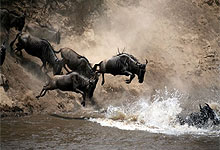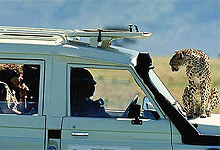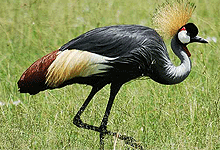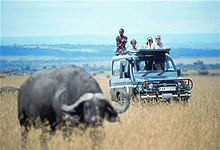Masai
Mara Game Reserve - Kenya
Maasai
Mara National Reserve (also spelled Masai Mara; known
by the locals as The Mara) is a large game reserve
in Narok County, Kenya, contiguous with the Serengeti
National Park in Mara Region, Tanzania. It’s
about 270 km from the capital Nairobi City and takes
about 5-6 hours by road or 40-45 minutes by flight.
)

Masai
Mara Game Reserve
|

Masai
Mara Game Reserve |

Masai
Mara Game Reserve |
Masai
Mara Game Reserve —
Kenya
Masai
Mara National Reserve View
Rates, Discounted Prices - Book & Save Now!
Masai
Mara National Reserve is one of the best known
and most popular reserves in the whole of Africa. It
is Kenya's finest wildlife reserve. Everything about
this reserve is outstanding. Seasoned safari travelers,
travel writers, documentary makers and researchers often
admit that the Masai Mara is one of their favorite places.
So
why is that? Perhaps it is because of the 'big skies',
the open savannahs, the romance of films like 'Out
of Africa' and certainly because of the annual wildebeest
migration, the density of game, the variety of bird
life and the chance of a hot air balloon ride.
South
Western Kenya is the heartland of the Maasai. The
Maasai are strongly independent people who still value
tradition and ritual as an integral part of their
everyday lives. They regard themselves not just as
residents of this area but that they are as much a
part of the life of the land as the land is part of
their lives.
Traditionally,
the Maasai rarely hunt and living alongside wildlife
in harmony is an important part of their beliefs.
This unique co-existence of man and wildlife makes
this Maasai land one of the world’s most unique
wilderness regions.
At
the heart of these lands is the Maasai Mara Game Reserve,
widely considered to be Africa’s greatest wildlife
reserve. The Mara comprises200 sq miles of open plains,
woodlands and riverine forest. Contiguous with the
plains of the Serengeti, the Mara is home to a breathtaking
array of life. The vast grassland plains are scattered
with herds of Zebra, Giraffe, Gazelle, and Topi.
The
Acacia forests abound with Bird life and Monkeys.
Elephants and Buffalo wallow in the wide Musiara Swamp.
The Mara and Talek rivers are brimming with Hippos
and Crocodiles. Each year the Mara plays host to the
world’s greatest natural spectacle, the Great
Wildebeest Migration from the Serengeti.
From
July to October, the promise of rain and fresh life
giving grass in the north brings more than 1.3 million
Wildebeest together into a single massive herd. They
pour across the border into the Mara, making a spectacular
entrance in a surging column of life that stretches
from horizon to horizon.
At
the Mara River they mass together on the banks before
finally plunging forward through the raging waters,
creating frenzy as they fight against swift currents
and waiting crocodiles. The wildebeest bring new life
to the Mara, not just through their cycle of regeneration
of the grasslands, but for the predators that follow
the herds.
The
Mara has been called the Kingdom of Lions and these
regal and powerful hunters dominate these grasslands.
Cheetah are also a common sight in the Mara, as are
Hyena and smaller predators such as Jackals. The Mara
is an awesome natural wonder, a place where Maasai
warriors share the plains with hunting lions, a place
of mighty herds and timeless cycles of life, death
and regeneration.
| |
 Masai
Mara Game Reserve Masai
Mara Game Reserve
|
 Masai
Mara National Reserve Masai
Mara National Reserve
|
Animals
& Birds of Masai
Mara Game Reserve
Wildebeest,
zebra and Thomson's gazelle migrate into and occupy
the Mara reserve from the Serengeti plains to the
south and Loita plains in the pastoral ranches to
the north-east from July to October or later. Herds
of all three species are also resident in the reserve.
All members of the "Big Five" are found
in the Masai Mara, although the population of black
rhinoceros is severely threatened, with a population
of only 37 recorded in 2000. Hippopotami are found
in large groups in the Masai Mara and Talek rivers.
Cheetah are also found, although their numbers.
The
wildebeest are the dominant inhabitants of the Masai
Mara, and their numbers are estimated in the millions.
Around July of each year these ungainly animals migrate
in a vast ensemble north from the Serengeti plains
in search of fresh pasture, and return to the south
around October.
The
Great Migration is one of the most impressive natural
events worldwide, involving an immensity of herbivores
some 1,300,000 wildebeests, 360,000 Thomson's gazelles,
and 191,000 zebras. These numerous migrants are followed
along their annual, circular route by a block of hungry
predators, most notably lions and hyena.
Numerous other antelopes can be found, including Thomson's
and Grant's Gazelles, Impalas, Topis and Coke's Hartebeests.
Large herds of zebra are found through the reserve.
The plains are also home to the distinctive Masai
giraffe.
The
large Roan antelope and the nocturnal bat-eared fox,
rarely present elsewhere in Kenya, can be seen within
the reserve borders. The Masai Mara is a major research
centre for the spotted hyena. Additionally, over 450
species of bird life have been identified in the park,
including vultures, marabou storks, secretary birds,
hornbills, crowned cranes, ostriches, long-crested
Eagles, and African pygmy-falcons.
The Mara birds come in every size and color including
common but beautiful ones like the lilac breasted
roller and plenty of large species like eagles, vultures
and storks. There are 53 different birds of prey.
Masai
Mara Game Reserve
Seasons
Altitude
is (4,875 —
7,052
feet) (1,500 —
2,170 metres) above sea level, which yields a climate
somewhat milder and damper than other regions. The
daytime rarely exceeds 85°F (30°C) during
the day and hardly ever drops below 60°F (15°C)
at night.
Rainy
Season: It rains in April and May and again
November and this can cause some areas of the Mara
to be inaccessible due to the sticky 'black cotton'
mud.
Dry
Season: July to October is dry and the grass
is long and lush after the rains. This is a good time
to come andsee the huge herds of migratory herbivores.
Hottest
time: The warmest time of year is December
and January.
Coldest
Time: June and July are the coldest months.
Masai
Mara Game Reserve Accommodation |
|
Masai
Mara Game Reserve Safaris & Tours |
|
Masai
Mara Game Reserve
Highlights
Bird
Watching
The
Masai Mara is a great place for bird watching enthusiasts,
with 485 species of birds recorded in the area. some
of these birds include the Crowned Crane, Marabou
Stork, Wattled Plover, Black Bustard, White Headed
Vulture, Jackson's Weaverbird, Ostrich, Tawny Eagle,
Nubian Vulture, Lilac Breasted Roller and the Superb
Starling
Hot
Air Ballooning
For
a completely different perspective of the game, try
a balloon safari. From your lofty viewpoint up in
the sky (usually around 100m high), you have a fantastic
view of the plains below, and the animals that inhabit
it.
Night
Game Drives
It
is totally different to a day time safari where you
see animals like Lion, Elephant, hippos out of water,
Dik Dik, Bat Eared Fox, Scrub Hare, the strange Spring
Hare which looks like a kangaroo when it jumps, Impala,
Thomson's Gazelle, a large herd of Giraffe including
six or so babies, lots of hyenas, jackals, Topi and
Wildebeest.
Exceptional
Lion sightings
Masai
Mara's black-maned lions are reputed to be the largest
and most impressive in Africa, and have been the subject
of numerous books and documentary films.
Wildebeest
Migration or “The
Great Migration”
|
The
wildebeest migration is one of the Seven
Wonders of the World and a main Kenya attraction.
The Wildebeest Migration in East Africa,
also known as “The Great Migration”
takes place between Kenya's Masai Mara and
Tanzania's Serengeti National Park and is
one of the greatest wildlife spectacles
on the planet.
Wildebeest Migration
| Click
Here
|
Booking
& Reservations for Masai Mara Safaris, Accommodation
& Tours in Kenya Contact:-
African
Spice Safaris
Booking
Office Tel: + 254 (0) 20 2437871
Mobile
: 0721-242-711 (Safaricom) - Kenya
Email:
[email protected]

